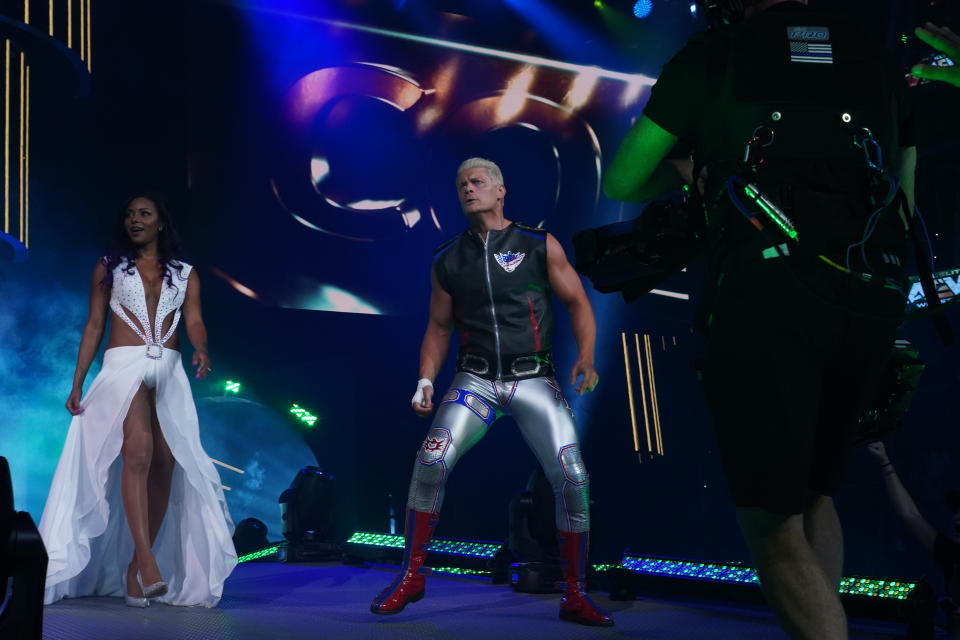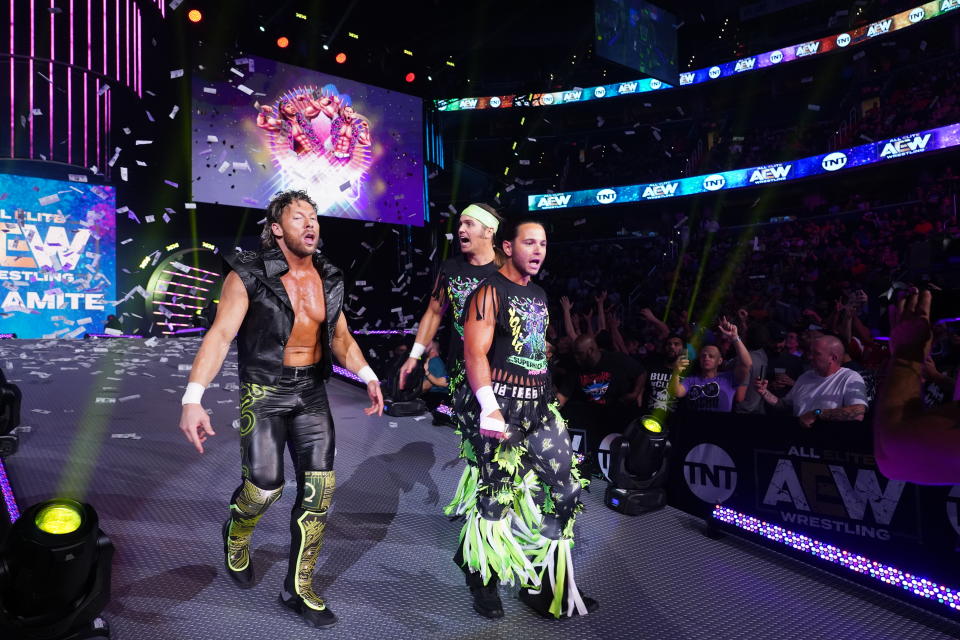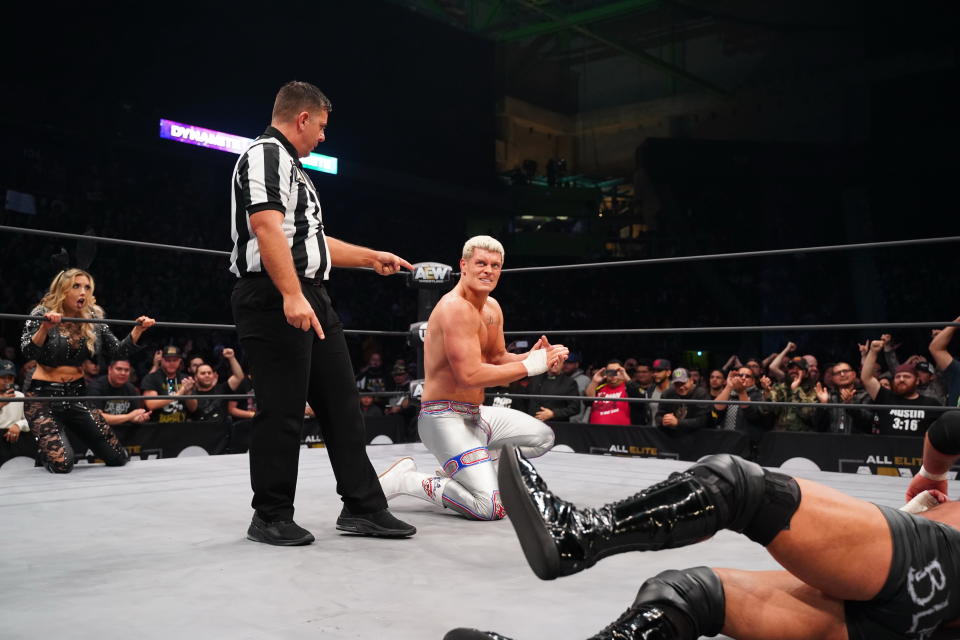One year later, AEW has disrupted pro wrestling and there's no plan to stop

It’s a Tuesday morning in Corpus Christi, Texas, and Cody Rhodes is wrapping up a series of media appearances and interviews promoting “Dynamite,” All Elite Wrestling’s signature — and to this point — lone television offering.
This particular edition, which features virtually every top talent the fledgling promotion has, is the final one of 2019. This is significant because 12 months earlier, AEW didn’t exist — at least not in its current, concrete form. The Corpus Christi show caps off a year that saw Rhodes and his colleagues disrupt the professional wrestling industry and generate a kind of buzz that hasn’t been seen in decades.
“It’s been a really unexpected journey,” Rhodes told Yahoo Sports. “Some of these milestones and achievements we’ve hit, I didn’t think we’d reach them so early. It’s very fun. I’m enjoying it.”
‘Our concern is not NXT’
While Rhodes’s journey began well before AEW was officially announced, the ambitious endeavor was revealed to the world on January 1, 2019. Rhodes, alongside fellow professional wrestlers Matt and Nick Jackson, made the announcement during an episode of their popular YouTube show, “Being the Elite.”
In the days and weeks following the announcement, AEW would take shape. A roster littered with major names such as Kenny Omega and Chris Jericho filled out. Roles of key executives such as Tony Khan and Brandi Rhodes were unveiled. A pay-per-view event, “Double or Nothing” was scheduled.
All the while, wrestling fans watched intently, wondering if AEW would truly be able to revolutionize the industry and pose a legitimate threat to Vince McMahon’s WWE conglomerate.
Internally, however, Rhodes and his fellow executives weren’t ready to make that comparison.
“We don’t actively say, ‘Hey this is different, let’s do this,’ it’s more the personalities behind AEW — Tony Khan at the top, Matt, Nick, Kenny and myself — the personalities are just different and we are the ones who create those scenarios,” Rhodes said. “We don’t have any of the template that WWE currently has. We’re open to everything, our bridges are open to all folks. When you have a wrestling company run by wrestlers, you cut out a lot of the bureaucracy, a lot of the red tape on situations like that. We don’t think about it being different, our focus is fun, and something like that was really fun.”
The initial success of AEW was somewhat unexpected. Tickets for “Double or Nothing” and “All Out,” the company’s first two tentpole offerings, sold out in minutes. AEW also utilized its partnership with Turner to introduce fans — both casual and hardcore — to its roster via free events such as “Fyter Fest” and “Fight for the Fallen” over the summer.
All of that would serve as a lead in for the biggest test AEW — or any wrestling promotion — could possibly face: Going toe-to-toe with WWE on cable television. AEW announced that it would air the first episode of “Dynamite” on October 2.
As the hype surrounding AEW built and WWE moved its NXT program from the WWE Network to the USA Network as more direct counter-programming, the industry was seemingly transported 20 years into the past, to a time where ratings reigned supreme and the “Monday Night War” was the hottest thing in professional wrestling.
Still, after three months on television, it’s a rivalry that Rhodes and AEW looks to downplay simply as a creation of fans looking for nostalgia.

“There’s a romantic way to look at the ratings and say ‘Here we are, it’s the late 1990s again. Every Thursday let’s check ‘em,’” Rhodes said. “It’s fun to look at the ratings but I know internally we’re not having any pep rally speeches. Our concern is not NXT and I believe NXT’s concern is not us. If anyone is going to succeed, we cannot be a reactionary brand. One really good, positive takeaway that the ratings war doesn’t show is that there is a lot less crossover between the fan bases, there’s a lot less of the turning the channel between one and the other. That means there’s a lot of people just watching wrestling on Wednesday nights. Making wrestling destination programming again is cool.”
A lesson for television: Less is more
Rhodes makes a valid point when he dismisses the idea of AEW and WWE being in direct competition. Simply put, the structure of the two companies is too different for them to truly be compared, at least for now.
WWE airs three live television shows each week and at least one pay-per-view event each month. When you factor in house shows, NXT TakeOver events and overseas specials, it creates a schedule that AEW neither wants nor is trying to replicate.
Everything AEW has done in Year One is designed from a concept that the company’s talent has shunned inside the ring.
“I think a lot of us have pushed back on ‘less is more’ with what we actually do in the ring, but that approach to TV is very true,” Rhodes said. “It creates the feeling that everything we are putting out for you in narrative is really important. Our titles, the fact that we only have the men’s, women’s and tag team championships at this point, we make them the most important thing from the company standard. When you approach it from that, you’re able to put things on a pedestal more and make things mean more from a narrative standpoint.”
This approach has translated into early success. AEW has sold more than 100,000 tickets to live events in 2019 and the debut of “Dynamite” was the highest-rated premiere on TNT in five years. Amid all of this, Rhodes, the Jacksons and Omega have made a conscious effort to introduce and feature new talent. None of the four EVPs, along with fellow “Elite” member Adam “Hangman” Page, have held a title yet in AEW.

Equal parts executive and talent, it’s a balance that isn’t easy to achieve.
“In my case, it was met with criticism internally because I was in the middle of the hottest run of my career and to take myself out of the title picture [wasn’t a popular decision],” Rhodes said. “I think we made it clear that we would be listening to fans. Part of listening to fans asking what if this were to become an Elite-only show? I love the Elite, but we didn’t want to monopolize the company so we made sure we put the fresh faces first. That’s the number one thing for recruitment into the company, the number one word, fresh.
“Everyone has done a great job. Kenny has taken a step back to help build up the women’s division. Matt and Nick have really cultivated a great tag-team group. Tony has kept us all on track. Even with this fandom going on, I’ve been able to do things diplomatically when it comes to our time. We want to make sure that when we said we were going to change the world and give better quality of life to pro wrestlers, that we present more than just the Elite.”
Rhodes and AEW have aimed to give a better quality of life to fans who come to their shows and those who watch on television as well. One of AEW’s unique features is its transparency and openness, particularly on social media. While pro wrestling has been and will always be a fan-driven medium, the personalities at the highest level of AEW have strived to make sure fan voices are heard.
“I love that there’s an open book on social media with me,” Rhodes said. “If there’s a problem or something you love, I’m able to react. To be able to return the excitement from fans with a little bit of love from one of us, that’s important. It was always going to be something that was vastly different from what we were doing before. In 2019, 2020, nobody wants to part with their money or their time unless they really feel heard and respected. I think they do with AEW.”
Take your bumps, move forward: AEW eyes geographic expansion in 2020
There have been some bumps, Rhodes admits. Despite having more than a decade of experience as a talent in the industry, Rhodes and the other “Elite” EVPs have had to learn the business and production sides of the company. Thankfully, Rhodes says he has been able to lean on Khan and leverage the excellent team that he has been surrounded with.
“The most difficult parts are the ones you don’t foresee,” Rhodes said. “When you’re looking at markets, demographics, minute-by-minute ratings, the clerical side of things, which is vastly important. That was an area where Tony linked us with some of the best people, like Chris Harrington and Rafael Morffi, to help provide the business side of things. The production side with Keith Mitchell and Kevin Sullivan. We’re able to give them our vision and they are able to provide their spark of magic.”

Ultimately, Rhodes is proud of the work him and the rest of the company has been able to do in just 12 months,
“I think if A+ is the top rating and we’re going off just the American standard, I think I would give myself an A rating,” Rhodes says. “I wouldn’t go higher because there’s definitely been some things that I have learned in regards to this. Just so that my rating doesn’t seem braggadocios or arrogant, the reason that I am so confident and optimistic about AEW is because of the fans. It beams across the television set, but if you come to one of these shows, these fans are nuts — in the best of way nuts. It’s a dream come true for a wrestler.”
As far as 2020 goes, AEW has already announced the first of its four tentpole events, “Revolution,” which will take place in February in Chicago — a marquee location for the promotion in its early days. While there are currently no plans to expand the television offerings, the next step for the company will be a geographic one, introducing new markets and fans to AEW.
“We’ve got to work our way across the country, spreading the brand,” Rhodes said. The number one way to hook the casual fan or the lapsed fan is that actual live experience. Moving west into places that some of our crew has never ventured into, that’s a real confidence booster. Giving fans a chance to see what’s the difference, why is this an alternative.”
More from Yahoo Sports:
